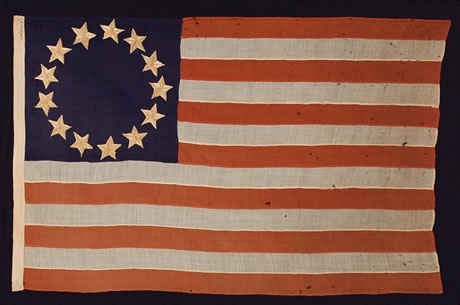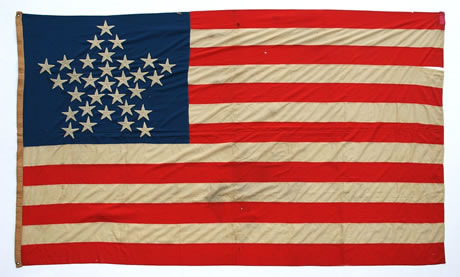You operate a fascinating business. When did you get interested in American flags?
As a dealer in antique American folk art, I became intrigued by the fact that the stars could be placed in any sort of arrangement that the maker wished until 1912. There was no official star pattern until that date, nor was there an official shade of red or blue, nor were there official proportions, so the flag could be square; it could be exaggeratedly long and skinny. As a patriotic person and a lover of history, I quickly became immersed in the story of our flag, which fueled my interest to specialize in them.
Describe your typical client. Who collects such rare and presumably expensive pieces of American History?
My typical client is a lover of history, politics, and art, who loves how these things are often combined in examples of early American flags. Because I stock examples ranging from about $250 to $250,000, my clients range widely in terms of their financial means, but most of my best clients are in the greater New York area. I find New Yorkers to be particularly patriotic. That was true well before 9-11 and it is arguably even more so today. I also have a large number of clients in Chicago, Florida, Texas, and California. Many are corporate executives, well-educated, and of course, patriotic.
You're the expert, tell us, did Besty Ross sew the first American Flag?
Unbeknownst to the vast majority of Americans, the star pattern most often associated with our first flag, as seen in countless books, motion pictures, and elsewhere, is the perfect circle of 13 stars. This is the design linked in American mythology to the seamstress Betsy Ross, who was long reported to have designed and made the first flag. Accompanying this act is a fabled tale in which George Washington, Robert Morris, and George Ross went to Betsy’s House and requested her to do so. Today flag historians know that a large body of research has dispelled the event. Betsy did make early flags—some of the first—but along with the myth of her being its creator, the concept of the stars having been placed in a perfect circle has also disappeared.
The Ross myth went public in 1870 when Ross's grandson, William J. Canby, presented a paper to the Historical Society of Pennsylvania, in which he claimed that his grandmother had "made with her hands the first flag" of the United States. Theoretically, the Betsy Ross design may have been revealed by Canby at that time, in which case one might expect to see 13 star flags made in the Betsy Ross perfect circle pattern shortly thereafter. One might especially expect to see them in use at the Centennial International Exposition in Philadelphia, the 6-month-long, World’s Fair event that was held to celebrate the 1876 event. In my experience, however, this is not the case and according to what is known about the Ross Family history, Canby did not reveal a specific design in 1870. In fact, no one knows when precisely the Betsy Ross pattern became linked with her name. In my experience buying and selling antique Stars & Stripes, 13 stars are almost never seen in a single, circular wreath until Betsy’s Granddaughter, Rachel Albright, began making flags in that pattern to sell to tourists in Philadelphia around 1898.
Among flag scholars, our flag is generally agreed to have been designed by Francis Hopkinson, a member of the Second Continental Congress from New Jersey and a signer of the Declaration of Independence. The original purpose of the flag was to mark American ships. Hopkinson was Chairman of the Navy Board's Middle Department under the Marine Committee. He was a natural choice, not only for this reason, but because of his expertise in heraldry. Hopkinson played a role in designing all sorts of devices, among them the Great Seal of the United States, the U.S. Treasury Seal, the U.S. Admiralty Seal, and various Continental currencies.
Hopkinson submitted a bill to Congress for the design, requesting that he be paid not in money, but rather with a keg of the federal wine. He was never reimbursed, which created a rift between Hopkinson and Congress. His original drawing consisted of a flag with 13 6-pointed stars, arranged in a 3-2-3-2-3 pattern of lineal rows.
So while Betsy Ross did make early flags—some of the first—and there are receipts to prove it—we have no idea how the stars were configured on her very first. Lots of evidence suggests, however, that they were not in a perfect circle.
You have about 1500 flags in your collection. Walk us through your favorite pieces?
One is a beautiful example from 1864, used in the presidential campaign of Abraham Lincoln and Andrew Johnson. The flag has an almost neon blue union (instead of the usual Navy blue) with a circular pattern of stars in different sizes and the candidates names printed boldly in the stripes. It was perfectly legal to do this until 1905 and Lincoln would have had this flag made to promote his candidacy. It also happens to be the largest known parade flag from the Lincoln & Johnson campaign, which makes it especially important.
Another is the earliest example of a Betsy Ross pattern 13 star flag that I have ever encountered. This is the first that I can confidently say pre-dates the flags that Rachel Albright began making around 1898 in Independence Hall in Philadelphia.
But my very favorite is one that was made for the 64th New York State Militia during the Civil War by local women, to be presented to their loved ones as they left for the battlefield. This beautiful presentation battle flag has all of its stars arranged in the form of one large star, with text intermingled in the pattern that identifies the regiment. It's the best of its kind that I have ever seen sold in the private marketplace. The unit was at Gettysburg, Fredericksburg, Chancellorsville, Yorktown, battle of the Wilderness, and many other engagements. It was a very hard-fighting group of gallant New York men.
I'm sure there have been several over the years but tell us about the piece that got away.
That's easy. A very rare portrait campaign flag made for the 1860 presidential run of John Breckinridge.
With the 4th of July just around the corner, please share some flag etiquette.
If you have it displayed outside over night, keep it lit at all times. If you are draping it vertically on a wall, make sure that the canton (blue area) is in the upper left. And make sure that no foreign flag is flown above it. But above all, simply be sure to display it somewhere for all to see.
|


|

